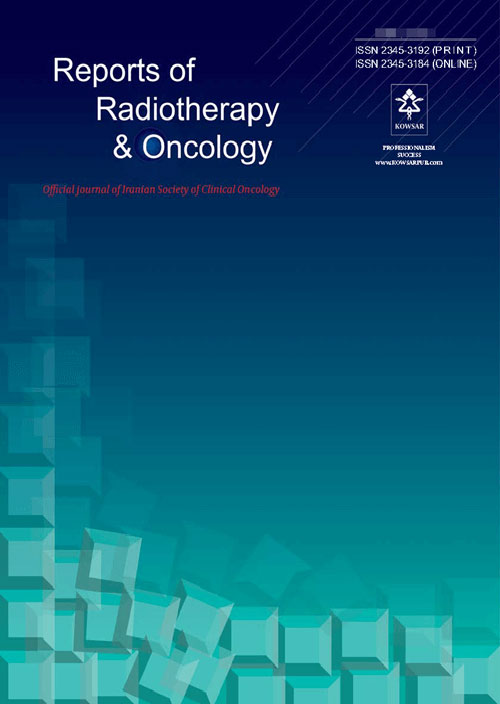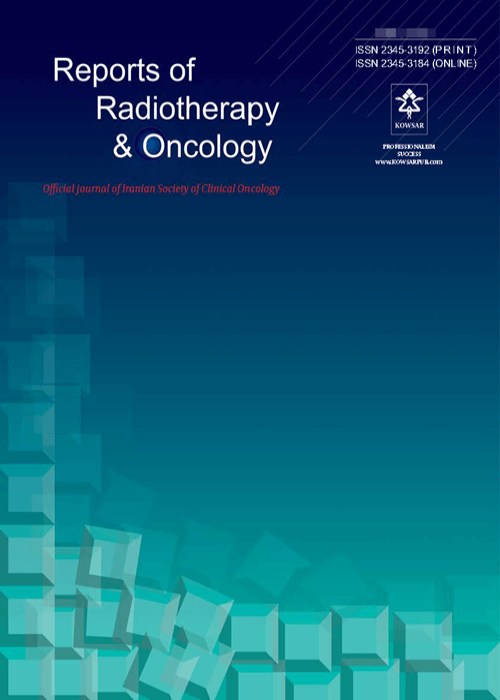فهرست مطالب

Reports of Radiotherapy and Oncology
Volume:7 Issue: 1, Dec 2020
- تاریخ انتشار: 1399/09/15
- تعداد عناوین: 8
-
Page 1Background
The prediction of normal tissue complications in treatment planning plays a critical role in radiation therapy of cancer.
ObjectivesThe aim of the current study was to evaluate mathematical models and clinical-dosimetric variables for prediction of radiation-induced hypothyroidism (RHT) in patients with head-and-neck cancer (HNC) and breast cancer (BC).
MethodsClinical and dose-volume data from 62 patients treated with three-dimensional conformal radiation therapy were prospectively analyzed in terms of HNCs and BC. Thyroid function assessment was monitored by the level of thyroid hormones from patients’ serum samples. Cox semi-parametric regression models were used to predict the risk of RHT. Model performance and model ranking were evaluated in accordance with the area under the receiver operating characteristic curve (AUC) and Akaike’s information criterion (AIC), respectively.
ResultsOut of 62 patients, 17 persons developed RHT at a median follow-up of 11.4 months after radiation therapy. Thyroid volumes above the cut-off points of 14.2 cc and 11.4 cc showed a decrease in RHT risk for patients with HNC and BC, respectively. Moreover, the thyroid mean dose above the cut-off points of 53 and 27 Gy increased the risk of RHT for patients with HNC and BC, respectively. Simple and Multiple Cox regression analyses of the complete dataset revealed that thyroid volume and thyroid mean dose were the strongest predictors of RHT. According to AUC, Boomsma’s model, and the generalized equivalent-uniform-dose (EUD) model in the HNC dataset outperformed the BC dataset.
ConclusionsThe probability of RHT rises with an increase in the mean dose to the thyroid gland; however, it decreases with increasing thyroid gland volume. Regarding the AUC analysis, gEUD model showed an acceptable predictive performance; however, the logistic Boomsma’s model wassomehowmore effective in predicting RHT on theHNCdataset. Cella’s model revealed a relatively acceptable prediction of RHT on the BC dataset.
Keywords: Radiation-induced Hypothyroidism, NTCP Model, Radiation Therapy, gEUD Model, Boomsma’s Model -
Page 2
Histiocytic sarcoma (HS) is a very rare neoplasm of hematopoietic origin characterized by the proliferation of malignant cells that have the morphological and immunohistochemical features of mature tissue histiocytes, with only a few cases reported. Most patients with symptoms of the unilateral or multichannel disease are more involved with the intestines, skin, and soft tissues, palpable mass lesions, and compressions of adjacent organs, such as intestinal obstruction, or constitutional symptoms (e.g., fever and weight loss). In this study, we reported a 56-year-old man with a six-month history of a cutaneous plaque lesion on the left arm’s posterior surface. He underwent skin lesion biopsy, histopathologic examination, and immunohistochemistry that was compatible with histiocytic sarcoma. Since surgical resection not deemed appropriate, our patient underwent aggressive multiagent chemotherapy with six cycles of ICE (ifosfamide, mesna, carboplatin, and etoposide) regimen and radiotherapy. After the completion of chemoradiotherapy, the skin lesion was completely disappeared. The patient is currently coming to us for the follow-up without any recurrence of the disease.
Keywords: Chemotherapy, Immunohistochemistry, Sarcoma -
Page 3
Cutaneous metastases from gastric cancer are quite rare, accounting for only 6% of all skin metastases in males and 1% in females. In case of occurrence, they are usually a sign of advanced disease and poor prognosis. This report presents a rare case of a 27-year-old male with gastric cancer who developed huge skin metastases and surprisingly, had a few visceral metastases. After four cycles of palliative chemotherapy, he discontinued the treatment and started to consume some herbal medicine. As he had a few visceral metastases, we presume that he passed away due to septic complications of the skin lesions rather than visceral crisis.
Keywords: Gastric Cancer, Skin, Cutaneous, Metastasis -
Page 5Background
Nasopharyngeal carcinoma is an uncommon head and neck cancer, which is commonly seen in young people aged from 15 to 25 years. Laryngeal cancer, on the other hand, is the second most common cancer among head and neck cancers. The primary treatment for patients with these carcinomas is radiotherapy.
ObjectivesThis study aimed at estimation of thyroid cancer risk, as an organ at risk after laryngeal and nasopharyngeal radiotherapy
Methodswith permission from the author, data related to thyroid dose of 20 patients who underwent radiotherapy of laryngeal and nasopharynx cancer in Soleimani et al. paper were used, and using the BEIR VII model, we calculated thyroid cancer risk.
Resultslifetime attributable risk (LAR) of thyroid increased up to 2.7% in the treatment of nasopharyngeal cancer and up to 1.8% in the treatment of laryngeal cancer. The highest LAR values belonged to the treatment of nasopharyngeal cancer.
Conclusionsradiotherapy for nasopharyngeal and laryngeal cancers considerably increased the risk of thyroid cancer in patients undergoing radiotherapy; such that the risk increased by more than 2.5% at younger ages. It is recommended to use an advanced treatment technique to reduce thyroid cancer risk and perform follow-ups annually in terms of the status of the thyroid gland and its changes.
Keywords: Radiotherapy, Laryngeal Nasopharyngeal Cancers, Thyroid Cancer Risk, BEIR VII Model -
Page 6Background
Prostate cancer is the second most common malignancy among Iranian men after stomach cancer. To understand the nature of the disease and plan and develop a population-based cancer registry, it is essential to recognize the clinical and pathological characteristics of the tumors, as well as treatment results.
ObjectivesThe present study aimed to evaluate the clinical and pathological characteristics of prostate cancer and evaluate the routine practice, including treatment outline and results of treatment in six referral centers in Iran.
MethodsThis prospective observational pilot study recruited patients with prostate cancer between April 2015 and October 2015 at six referral centers in Iran. The participating physicians included consecutive patients according to inclusion criteria. Demographic, clinicopathologic, and treatment data were collected by the physicians using an electronic case report form (eCRF). The patients were followed for 18 months, and during this period, four visits were scheduled for each patient to collect the data.
ResultsA total number of 102 patients from six centers in five different cities of Iran were included in the study. Sixty-seven (65.7%) patients were diagnosed by needle biopsy as the first diagnostic method, 23 (22.5%) by radical prostatectomy, and 12 (11.8%) by open prostatectomy. Total at-risk times of patients for overall survival (OS) and progression-free survival (PFS) were 1480.9 and 1437 months, respectively. Median (IQR) values of OS and PFS were 18.2 (9.2 - 20.5) and 18.2 (6.8 - 20.4) months, respectively. Forty (39.2%) patients underwent surgery, 58 (56.8%) underwent radiotherapy, and 13 (12.7%) received chemotherapy. Twenty-nine (28.4%) patients experienced adverse events over the follow-up period. Eight deaths were reported that were unrelated to treatment adverse effects.
ConclusionsThis pilot registry could serve as a valuable tool for the development of a comprehensive nationwide registry for patients with prostate cancer in Iran.
Keywords: Treatment, Epidemiology, Prostate Cancer, Registry -
Page 7Background
Epstein-Barr virus (EBV) is a herpes virus, which is the cause of infectious mononucleosis. Seroepidemiological studies show that more than 95% of adults in the world are infected with this virus. This virus is a modifying virus that is associated with some malignancies such as Burkitt lymphoma, tumors in HIV-infected patients, Hodgkin's lymphoma, head and neck tumors, and T-cell lymphoma.
ObjectivesThis study aimed to determine the prevalence of EBV and its relation to the type of cancer in patients with head and neck tumors, which were treated in the years 2015 to 2016 at Shahid Rajaee Radiation Hospital in Babolsar.
MethodsDuring one year, all patients with head and neck tumors were monitored, and finally, a total of 37 patients who had pathologically confirmed diagnoses were entered into the study after obtaining written informed consent. In this descriptive study, specific anti-EBV viral capsid antigen (VCA) immunoglobulin M (IgM) and IgG antibodies were evaluated using enzyme-linked immunosorbent assay (ELISA). Also, other patients' information was obtained from their records.
ResultsThe mean age of the patients was 59 years, and the number of men (70.23%) was higher than that of women (29.77%). Regarding the histopathology information and the frequency of tumors, most of the patients had squamous cell carcinoma (SCC) (73%) in the sites of the nasopharynx (27.02%) and pharynx (18.91%). The results of the ELISA test showed that IgG antibodies were positive in most of the patients (86.5 %). About the relation between the sites of the tumors and the IgG antibody, all patients (100%) with nasopharyngeal, tongue, and lips cancers were positive while they were the least in pharyngeal cancer (5.4%).
ConclusionsThis study showed that a significant number of patients with head and neck tumors (86.5%) were infected with this virus, which indicates that EBV as a carcinogenic agent in head and neck tumors has a high prevalence in our society and requires preventive and therapeutic actions.
Keywords: EBV, Head Neck Tumors, Shahid Rajaee Radiation Therapy Hospital of Babolsar -
Page 8Background
The Iranian radiation oncology board examination (IROBE) includes a multiple-choice question (MCQ) examination and an objective structured clinical examination (OSCE). The current mission of IROBE is to qualify the graduated residents (GRs) in terms of clinical competence. However, lack of active monitoring of its construction and administration can impair the evaluation of GR competencies.
ObjectivesTo determine the strengths and limitations of IROBE.
MethodsThis cross-sectional online survey involved faculty members (FMs) and GRs as constructors and participants of the IROBE, respectively. The target time window for inclusion in the study was set between 2015 and 2019. To evaluate the strengths and limitations of IROBE, a 22-item questionnaire was distributed among FMs and a 29-item questionnaire among GRs. The Mann-Whitney U test and Pearson’s chi-square test were applied to find the association between the ordinal and nominal variables, respectively.
ResultsThe surveys were sent to 35 FMs and 107 GRs. A total of 16 (45%) FMs and 42 (39%) GRs completed the survey. Overall, the majority of FMs and GRs stated that IROBE has average to poor quality in evaluating all aspects of clinical abilities (62.5 vs. 76.1% in clinical competence, P = 0.07; 62.5 vs. 71.4% in clinical knowledge, P = 0.19; 100 vs. 92.9% in medical ethics, P = 0.21; and 93.7 vs. 95.3% in responsibility, P = 0.15). However, FMs assigned a higher score to OSCE in the assessment of clinical performance compared to GRs (P = 0.02). Most FMs and GRs declared that IROBE requires extreme to high improvement in both MCQ and OSCE components (75 vs. 59.52% and 87.5 vs. 90.47%, respectively).
ConclusionsAccording to the participants, the present structure of IROBE has several drawbacks in both MCQ and OSCE components. Considering the highlighted strengths and limitations can help the IROBE constructors to improve its quality
Keywords: National Board Exam, Radiation Oncology, Resident, Faculty Member


